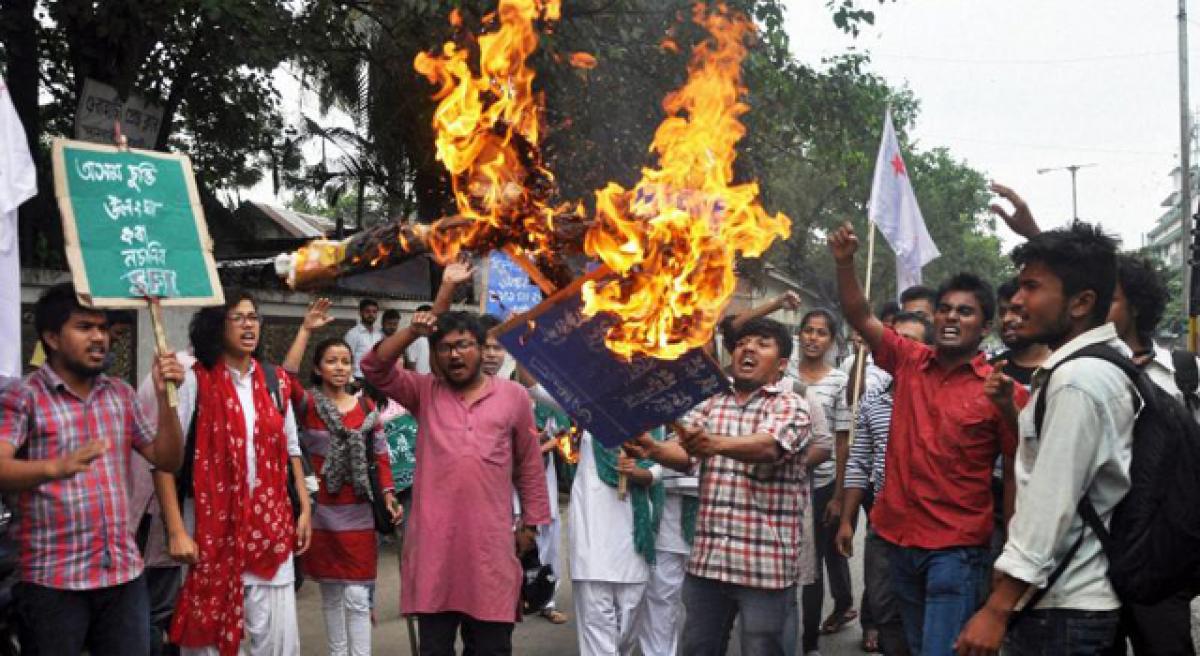Live
- 15 Telangana boys bag perfect 100 percentile in JEE Mains Session–II
- Bheemili developed with Rs 3,800 cr in TDP rule: Ganta
- Special Police Observer reviews poll arrangements
- TS LAWCET, PGLCET registration date extended
- Andhra Paper lockout creates stir
- Cyberabad cops ban drone flights for V-P visit today
- Petrol and diesel prices today stable in Hyderabad, Delhi, Chennai and Mumbai on 26 April
- Gold rates in Delhi slashes, check the rates on 26 April 2024
- OU comes alive with vibrant celebration of Taksh festival
- Gold rates in Vijayawada slashes, check the rates on 26 April 2024
Just In

The publication of the first draft of the updated National Register of Citizens (NRC) of Assam by the Office of the State Coordinator of NRC on December 31, 2017 is an important milestone in dealing with the influx of illegal migrants from Bangladesh into that state.
The publication of the first draft of the updated National Register of Citizens (NRC) of Assam by the Office of the State Coordinator of NRC on December 31, 2017 is an important milestone in dealing with the influx of illegal migrants from Bangladesh into that state. The objective behind updating and publishing the 1951 NRC is to compile a list of the names of genuine Indian citizens residing in Assam and, in the process, detect foreigners (read Bangladeshis) who may have illegally entered the state after March 24, 1971.
Of the 3.29 crore residents of Assam who applied for the inclusion of their names in the NRC by submitting legacy documents, 1.9 crore names have been included as citizens in the initial list. A second list containing the names of more numbers of citizens is slated to be published in February-March 2018. The final list containing the names of all Indian citizens in Assam is expected to be published by December 2018 after the disposal of all claims and objections in final registers at various levels.
The publication of the initial NRC list is the outcome of a long standing demand of the Assamese people to detect and deport illegal Bangladeshi migrants from their state. Early demands for the detection of foreigners based on the NRC of 1951 can be found in the memorandum submitted by the All Assam Students Union (AASU) to the then Prime Minister on February 2, 1980 as well as in the signed petition submitted by 17 members of the legislative assembly (MLAs) of Assam to the Rajya Sabha in June 1980. Yet, the Assam Accord of 1985 did not contain any specific mention of updating the NRC.
With regard to the issue of illegal Bangladeshi migrants, clause 5.8 of the Accord merely stipulated that “Foreigners who came to Assam on or after March 25, 1971 shall continue to be detected, deleted and expelled in accordance with law. It was only in May 2005 that the first step towards updating the NRC of 1951 was taken, when a tripartite meeting between the Centre, the Assam government and AASU was held to review the progress made in the implementation of the Assam Accord.
Given that a proper documentation system does not exist in the country, for most of those whose names do not appear in the NRC, procuring the required documents, especially birth certificates, in order to prove their relationships with persons whose names have appeared in the legacy documents and thus establish their citizenship is fraught with difficulties. This is particularly so in the case of many settlers who have come to Assam from other parts of the country.
An even more important issue is what happens to those people whose names do not figure in the final NRC and are declared illegal entrants into the state. The popular rhetoric for dealing with such illegal migrants has always been to deport them to Bangladesh, but this is easier said than done. Bangladesh has consistently denied that its citizens have illegally migrated to India.
The publication of the updated NRC is indeed a positive step in so far as it puts to rest wild speculations about the extent of the illegal migrant population in Assam and the resulting polarisation that political parties have been exploiting to make electoral gains. However, the absence of any clear policy as to how to deal with the proclaimed illegal migrants has created a sense of unease in the minds of many presently residing in Assam.
Further, while the NRC is being updated for Assam, there is no plan to prepare similar NRCs for the other states in the North East where illegal migration continues to be a volatile issue. The need of the hour therefore is for the Union Government to allay apprehensions presently in the minds of the people of Assam and take steps to contain any adverse fallout after the publication of the final draft of the NRC. (Courtesy: https://idsa.in)
By Pushpita Das

© 2024 Hyderabad Media House Limited/The Hans India. All rights reserved. Powered by hocalwire.com







